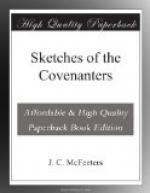How much does the spirit of zeal, courage, witness-bearing, and discipline, stir the descendants of the martyred Covenanters in the present day?
* * * * *
Points for the class.
1. What may be said of Cargill’s last years of service?
2. How many years of persecution did he suffer?
3. What aroused him against the king?
4. What official act did he perform on the king and six others?
5. What was the nature of this excommunication?
6. How did he protect himself against wrong criticism?
7. Was his prophecy fulfilled?
8. How did Cargill die?
9. What service is much neglected in the Church in our day?
XL.
The societies.—A.D. 1682.
After the death of Cameron, the Covenanters of the Cameronian type formed themselves into societies for the worship of God, for their own spiritual edification, and for the defence of the Covenant. Half a dozen families or more, having the same faith, spirit, and purpose, met together on the Sabbath day, to engage in social worship. This was called a society.
Those were days of woeful declension. Defection had swept the great body of Covenanters from their basis. Under the strain of persecution and the snare of the royal Indulgence, many ministers and people had abandoned wholly, or in degree, Reformation grounds. The Society People alone refused to make concessions by which truth would be suppressed, conscience defiled, or any divine principle surrendered. They stood by the Covenant, and accepted the consequences, including hardest service and greatest sufferings.
The Society People have been censured for exclusiveness; they refused to associate with others in the worship of God, and would hear no ministers except their own. But why? Consider their reason, then let them be judged. These people stood alone simply because they had been left alone; these soldiers of Christ had been deserted while holding the ground won by their fathers at the cost of much blood. They stood where the Lord Jesus Christ had placed them, giving them a solemn charge to keep the oath, and defend His royal rights. Should they then be reprimanded, for not joining in the general stampede? What saith the Lord? “If any man draw back, my soul shall have no pleasure in him.”
From the fortress of the Covenant these veterans of Christ heroically waved the Blue Banner, declaring to their brethren, and to the world, that by the grace of God they would never surrender. They were the real Covenanters, the true blue, the old stock. They were not a faction; they were the remnant. They stood on the original ground; the others had broken the Covenant and had departed. These were the core, the center, the substance, the personnel, the integral force, the organized body, the visible form, of the Covenanted Church in those days. The Societies were the continuity of the Church that had flourished in the days of Knox, and took on later and greater glory in the times of Henderson. They were the same Church, holding the same faith, the same Covenant, and the same services.




